By Austin Lefevre
Introduction
We’re getting to the point in the marine aquarium hobby that hearing the word “quarantine” tossed around casually at a local fish store is commonplace. It’s refreshing. Word is starting to get out that these fishes have just gone through the most incredibly stressful adventure of their lives. With that in mind, these fishes are then plopped into a small clear tank with minimal filtration and expected to be happy and eat flakes tomorrow. Ah, good luck with that. What seems to get overlooked is how many little, easily performed actions we can take to make the end of this journey a smooth transition.
As previously mentioned quarantine is thrown out as the word of choice regarding these initial transition aquariums. And with good reason; they’re quarantining newly acquired fishes from our beloved established fishes. However I consistently see this term immediately associated with dosing medications, which should be the last thing on your mind right after acclimation. The medications are there when we absolutely need them, however most are pretty rough on fish so avoiding them until necessary is the safe bet. The main reason for these tanks is to condition fishes to our captive environment.
Remember the adventure mentioned earlier? It started with the fishes being collected in their natural region and housed on a boat in a small container for a day or more. Then they were bagged and taken to an exporter who shipped them overseas. Once received in customs they were inspected, sometimes re-bagged, than picked up by the wholesaler who tanks them. The wholesaler cares for the fish until moved onto a retailer, who cares for the fish until it ends up in your hands. After you take a breath and look back at that list it’s easy to see why it’s so crucial to know where your fish are coming from, or at the least have a vendor(s) you trust to do that for you. Don’t get duped by an overtly cheap fish. Somewhere along the line someone took shortcuts that you don’t want to have to deal with. If every hobbyist practiced this, said someone puts themselves out of business by their own shortcomings.
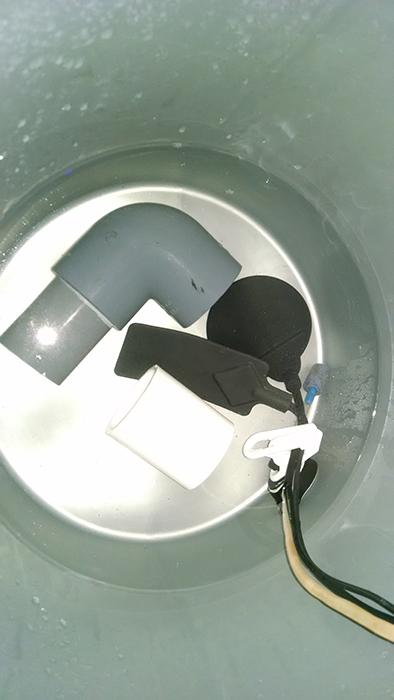
Acclimation bucket ready for fish consisting of two mini Hydor heaters, one aeration stone (turned off for picture) and PVC fittings for fishes to hide in.
Acclimation
First and foremost let’s get these fishes out of their bags and safely into their quarantine aquariums. There are plenty of resources out there on proper ways to acclimate fishes. Your favorite retailer should be one of the first places to look. Suffice to say that for most hobbyists a simple twenty to thirty minute drip acclimation should be adequate. If your fish transitions through acclimation with little visible stress, I often recommend the use of Blue Life USA Safety Stop to my clients (if they’re sourcing fishes elsewhere). We’ve found it to be a very mild prophylactic therapeutic treatment and it should not be seen as an extended medicated period. Once the fish have been acclimated and/or gone through Safety Stop they should be caught with your hand or a container and added to their quarantine aquarium. Avoid the use of nets when possible. Nets can stress fish out; as the net closes in on them their whole world disappears and they’re yanked out of the water. Fishes gill spines, dorsal spines and other fins can get caught in nets requiring you to forcefully pry them out. The exception always noted here is when trying to avoid adding water from the fish bag to the quarantine aquarium, to which I say go ahead and add a bit of the water to an uninhabited (animal wise, anyway) quarantine tank. Your fish was just swimming in it anyways. If the use of a net is necessary for whatever reason, look for a fine mesh net as they tend to be softer and not snag fish as frequently.
Quarantine Aquarium
Quarantine tanks should be well established prior to adding fish. The use of the largest hang-on-back power filter that you can fit onto the aquarium is going to help keep water quality high with little interference from you. My go-to system is a standard ten gallon aquarium with an AquaClear 70 hanging on the short side. The flow from the filter keeps all food and detritus in the water column, allowing very little detritus and sediment build up. The flow also helps keep fishes active and healthy, while providing a natural current most fishes are accustomed to which will help reduce stress levels. We run all quarantine tanks without substrate to keep detritus in suspension and for ease of medicating if necessary. Sand is used in removable containers for specific sand dwelling species.

Our custom built quarantine aquariums which snugly fit AquaClear 70’s prevents jumping though tiny holes and provides optimal flow patterns.
I’ve heard the argument that quarantine tanks are expensive to keep running while not in use, although considering the AquaClear 70 pulls a whopping 7 watts (in my area that equates to $0.51 a month) I call shenanigans. In most situations a heater should be added to your quarantine aquarium to keep temperature stable. Make sure not to skimp here just because it’s a quarantine tank; heaters are the most evil piece of equipment we keep since they can cause a crash quickly on their own. Adding a heater controller inline will add an additional point of failure protection, which if quarantining expensive fishes is an excellent means of keeping our stress levels down. If you’re really lucky and have a room with temperature that remains stable enough to keep your quarantine aquarium temperature within proper range, then by all means do not add a heater. There’s no need to run the heater if the tank is sitting fallow for an extended period of time, we have several that fall into the high 60’s (°F) and beneficial bacteria will still reproduce. Turn the heater on roughly forty eight hours prior to adding your fish allowing the system time to stabilize. Another reason to choose the smallest quarantine tank possible is to help keep salt and medication (if necessary) costs down. When fish are first introduced we perform a minimum of 25% water change every forty eight hours to keep water quality as high as possible. Match salinity and temperature as closely as possible, and aerate your water change water for twenty four hours.
Cover
The next thing to consider is cover for your fish, and by cover I’m talking about places to hide and feel comfortable as opposed to a top. But you better damn well have a top on your aquarium too! I prefer the use of glass or acrylic tops to help keep evaporation and salt creep down. I cut them to butt right up against the filter to prevent jumping. Plenty of air exchange still occurs at the filter outlet allowing for sufficient oxygenation of the water. Now back to hiding places. We should avoid the use of live rock here, and rely on PVC fittings, faux plants and potentially those other cheesy decorations that I refuse to put into any of my clients display aquariums. Fish will be drawn to these just the same as a staghorn coral, and call them home. These hiding places can be easily disinfected after each use leaving no worry of transferring ailments or leaching potential nasties back into the water column. The next part of cover for your fish is simply cover from us, and other movements in the room outside their aquarium. Fish see movement on a TV, they see that cat perched next to the tank looking at them like an interesting snack, they see your four year old toddler whipping back and forth on his big wheel (I’ve just dated myself) like a bat out of hell. Fish do not like these things. Especially for a freshly transferred fish, all of these random movements outside of their tank will cause their stress level to rise. This is easily avoidable by covering the tank in some manner, with my preferred method being painting all sides but one. Fish can see their own reflection in the bottom of a bare bottom aquarium, which can actually stress them out as well; they’re scaredy-cats! And for good reason considering pretty much everything in the ocean is out to eat you and your entire family. So I paint all sides but the front (which for my ten gallons is one of the short sides) allowing us to still keep an eye on the fish. When my fish are first introduced into their quarantine aquariums we take it one step further and cover the front with a towel being held on with magnets. We can still peer over the towel to inspect the fish, although the fishes are now not seeing any movement at all besides what’s happening inside their aquariums, and the occasional person slowly peering over the top and dropping in food a dozen times a day. Over the course of a couple weeks the fish will noticeably begin to settle in and towels are removed so fishes can be easily viewed.
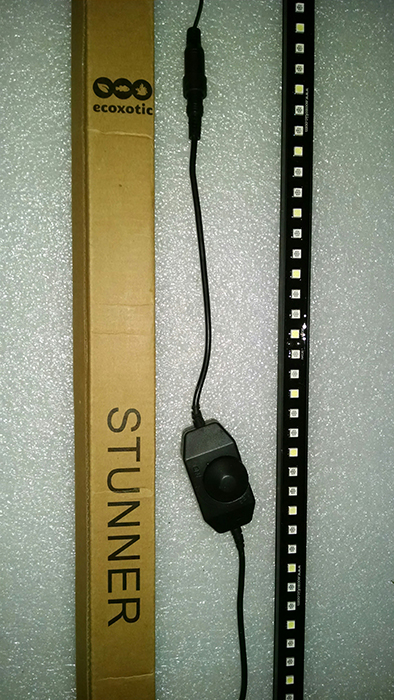
Ecoxotic Stunner Strips 12,000K White/445nm Blue are used throughout our quarantine systems. The receiving tanks are outfitted with dimmers.
Lighting
Lighting for a quarantine tank is obviously important so we can keep a close on the health of fishes however not near the cost or consideration of a light for our reef aquariums. You want to avoid bright lighting, particularly for freshly transferred fishes. They’ve [likely] just come out of a completely black box and we’re now blasting them with light. During acclimation of fishes in the office we keep shades closed and ambient room light to a minimum. Lights on the quarantine system are kept off for 24 hours, than just barely turned on thereafter. By “just barely” I’m referring to the dimmers we use on Ecoxotic LED Stunner strips. I’ve found these lights (or similar) to be perfect for a quarantine system. The dimmer allows me to slowly ramp up lighting over the period of a week or more while the fishes are being accustomed to it. Some places actually use red lighting during initial acclimation due to red lights long wavelength, which causes it to dissipate faster in water and is hardly noticeable by fish. With that said I have a hard time checking for ailments with just red lighting and have preferred the dimmer method with more hobby standard 20K LEDs. Just as in a reef tank the light should be kept on a stable photoperiod to keep fishes comfortable. Anywhere from eight to twelve hours is an acceptable range for a quarantine photoperiod, error towards shorter to save energy.
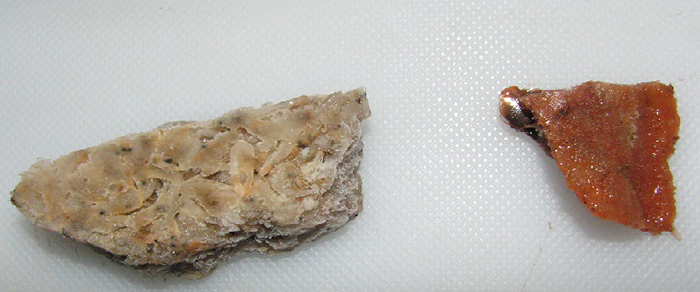
Prepping food for feeding on cutting board. We rinse all Mysis in RO/DI water to remove residual oils. Do not rinse all-in-one foods or enriched Artemia.
What To Feed?
Feeding of freshly transported fishes is nothing to take lightly, and one should be well prepared with various foods prior to receiving your fish. You don’t want to have to run around town searching for foods that might work since a fish isn’t eating. One thing we always have on hand while conditioning new fish is live Artemia, or brine shrimp. Any decent local fish store will carry or hatch their own brine shrimp, and is generally sold for only a couple dollars per bag. You can hatch your own brine shrimp if you would like but it’s a royal pain in the rear compared to picking up a couple bags of ready to feed Artemia a week. We house Artemia in a small container with an air stone and feed Phyto-Feast by Reef Nutrition to help raise the nutritional content of the Artemia; this is called gut-loading. Artemia is not a viable long term food for pretty much any fish, but they create phenomenal feeding responses from fishes since they’re live. The most important step of feeding new fish is getting them to eat, which makes sure that some calories are being ingested by the fish, even in miniscule amounts. As fish start to settle in we can start offering other prepared foods. Our go-to staples, in order of what we’ll feed first to last:
-Hikari Spirulina Enriched Brine Shrimp (Crude Protein 6.9% min.; Crude Fat 1.6% min.). This is a good step after live Artemia. They look similar to live brine and are enriched with nutritious spirulina. However they are frozen, which initially for most fishes means it’s entirely unrecognizable as a food source (since not moving), so some fish may take some time to start readily accepting this food. Try mixing some in with live brine shrimp. Eventually they’ll sample a piece and voila, light bulb! They start to recognize the frozen floating bits as food.
-Piscine Energetics Mysis Shrimp (Crude Protein 69.5% min.; Crude Fat 8.35% min.). This is one of the most nutritious foods on the market, and is readily accepted by most fishes once they take to frozen fare. For some fishes P.E. Mysis is quite the mouthful (too big), so they should be chopped up or ran through a power head to make smaller. Another option here is the small Hikari Mysis (Crude Protein 10.5% min.; Crude Fat 1.0% min.) as some fish won’t recognize chopped up Mysis as a food source. Sometimes they have to see the full body of the shrimp to evoke a feeding reaction. Picky fish make my mother seem like a godsend when it comes to food, and she’s the type to order her “Veggies on the side so the juices don’t mix”. Ugh. However a quick glance at the guaranteed analysis numbers sourced from manufacturers respective websites shows just how much more potent each piece of P.E. Mysis is compared to any other Mysis counterpart. Still, remember that getting the fish any food is more important than a specific food, initially.
-LRS Reef Frenzy (Crude Protein 10.4% min.; Crude Fat 2.23% min.). This is a newer food to hit the market that is making its rounds throughout the US. LRS Reef Frenzy is an all-in-one type food, containing seventeen fresh ingredients (standard blend) that we’ve experienced some pretty incredible results with. I’ve had fresh off the plane Chelmon rostratus (Copperband Butterflyfish) feeding on LRS Reef Frenzy within 24 hours of being removed from the bag. Although this is a frozen food the ingredients seem to evoke an irresistible feeding response in most fishes. One thing to be careful with these all-in-one foods is excess waste. In a quarantine aquarium you ideally want every piece of food you put into the aquarium going into a fishes mouth. Anything else becomes waste and leads to water degradation. With that in mind feed all-in-one foods sparingly, taking your time while feeding to make sure the majority is consumed.
-New Life Spectrum pellets. We have many clients that never touch their aquariums, including automated feeding. Unfortunately at this point there is not a reliable, affordable automatic frozen food feeder, so many of our fish are kept in conditioning systems until they’re readily taking pellet foods. Over the years we’ve found NLS to be an excellent pellet food accepted by most fishes once they’re weaned onto pellets. Weaning fishes onto pellets can take months for some species, so don’t get disappointed if they’re still not accepting them on week six. For the majority of fishes we use Thera+A 1mm sinking pellets (Crude Protein 38% min.; Crude Fat 7.0% min.)
Those are the four main frozen foods (and one pellet) we keep on hand, and we’re able to get 98% of fishes we receive eating utilizing those foods alone. Sometimes we bring in frozen clams for specific species which we’ll touch on more below, and we always offer Nori on an algae clip to any herbivorous fishes.
How To Feed
The way we approach feeding is just as, if not more important that what we’re actually feeding. These new fishes are not the voracious feeders we’re used to seeing in our established display aquariums, where a standard cube of food disappears in seconds, and they cannot be fed in the same manner. As mentioned above it’s important to make sure the vast majority of food added to the aquarium is eaten. For one ~2” fish we literally add three to four individual P.E. Mysis shrimp (or equivalent amount of another food) and wait for a feeding response. If the fish takes it down quickly by all means add a little bit more. It should be noted that when feeding live Artemia we do turn off the filter allowing fish ample time to consume the food. With frozen food we tend to leave the filter on causing the food to move around making it appear live to fishes. This is why it’s crucial to add small amounts to prevent a filter full of food fouling water. Newly received fishes are fed no less than a dozen times a day, at least a half hour apart throughout their photoperiod for the first two weeks. Generally at the two week mark we’ll reduce frequency by half as fishes have put on a good amount of weight by then. For the most part fishes are fed six times a day until they’re moved out of our conditioning systems and into a clients tank where they’re fed a more manageable two to four times per day.
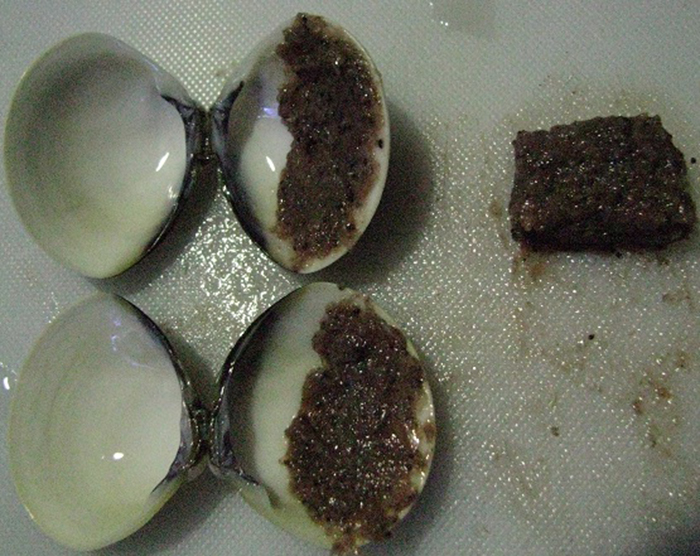
We often mix Mysis with other foods once thawed to spread onto clam shells or coral skeletons to evoke best feeding response. These shells are ready to be added to a quarantine aquarium.
Everything mentioned above is assuming fishes are readily accepting food out of the water column. Some species in nature never feed out of the water column, rather they graze all day long picking at rocks and the substrate, and have to be weaned into the mindset that food floating past them is actually edible! Of course these are generally my favorite two families of fishes, Pomacanthidae and Chaetodontidae (Angelfish and Butterflyfish). Many times our first food offered to these two families is frozen Mercenaria mercinaria (commonly called “littleneck clams” based on size). They can be purchased at most grocery stores, and any Asian market. Make sure to purchase frozen clams to prevent ailments from being transferred from clams to fish. If you can only source live clams simply freeze them yourself. To offer a start by thawing the clam in RO/DI water, prying open with fingers or a clean flathead screwdriver, than slicing through the meat with a sharp knife or razor blade. I’ve found the slicing helps fishes rip off good size edible chunks. Gently drop the clam into the aquarium and observe feeding response. The next step with substrate grazing fishes is to get them on more easily fed frozen foods. If the fish is not readily taking frozen foods from the water column than we take either empty clam shells, or coral skeletons (when working with corallivores) and smear thawed frozen foods into the crevices, nooks and crannies. I do this the second food is pliable enough to smear, than add to the quarantine aquarium. You can pre-make several of these and freeze them for future feedings. It should go without saying that the shell or skeleton should be completely disinfected prior to smearing foods. If the fish refuses the smeared frozen foods don’t let up! Start adding a thawed clam along with a food laden clam shell, and eventually they’ll get the idea. Make sure to remove clam shells within a couple hours of sitting in the tank to prevent fouling water, whether they’ve eaten it or not. Do not re-freeze once removed from the aquarium, start fresh each time to prevent offering spoiled food.
Observing Fishes
Now we’ve looked at what and how to feed, but what’s the best manner to observe fishes during feeding without making them cower from our large predacious eyes and mouths staring at them from inches away? For starters, don’t stare at them from inches away!
Feed the tank slowly with aquarium lights on and ambient room lights off. Take a few steps back without making any sudden movements and observe. I’ve been known to dress up like the Unabomber to prevent overly skittish fishes from noticing my eyes or mouth, and guess what… it works like a charm! Covering the majority of the viewable pane initially really helps fish feel more at home, and if done properly you can still get a good look at feeding responses.
Medicating Fishes
There are entire books dedicated to medicating fishes so I won’t be getting into much of that here. If sourcing healthy fish followed by acclimating and conditioning properly, chances are you won’t have to use any medications. There is something to be said about prophylactically treating fishes for incredibly common ailments with various medications. The only medication we use on every fish that passes through our tank is praziquantel, in the form of PraziPro by Hikari. PraziPro is an incredibly mild formulation of praziquantel that will eliminate flukes, tapeworm, flatworms and turbellarians. We start with half the recommended dose, observe for twenty four hours, then add remainder if fish looks well after initial dose. We run treatment for seven days followed by a large water change, wait three to five days, and repeat for a second treatment.
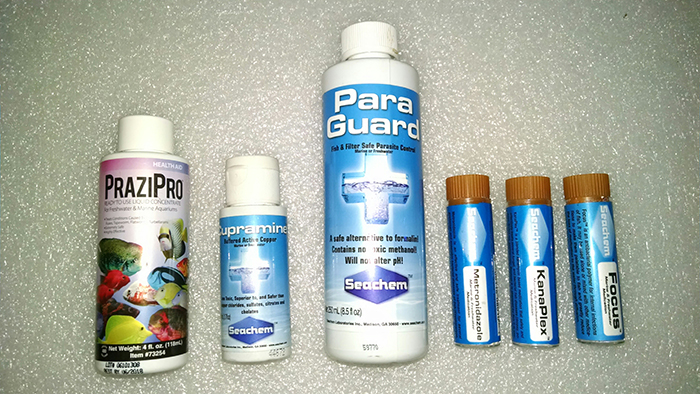
Part of our medication arsenal. You want to have a solid fish med cabinet on hand so you don’t have to rush around at the last minute. Be prepared, just in case.
Another medication we commonly use is copper, in the form of Cupramine by Seachem. Cupramine tends to be the most mild and easily used form of copper available in the marine hobby. It should be noted that we only treat with Cupramine when necessary, opposed to prophylactically. The best advice I ever received regarding treating with Cupramine was to add the recommended dose slowly. Seachem states to add half the full dose on day one, wait forty-eight hours, then add the remainder. We add about one quarter of the full dose, wait fourty eight hours, add an additional quarter, wait forty eight hours, and so on until the final concentration of 0.5 mg/L is reached. This is due to the fact that copper medications wreak havoc on fishes kidneys, which is why many will stop eating for seemingly no reason once copper is added. The reason is that copper levels were brought up too fast! Take it slow, and watch your copper levels throughout the entire treatment. Copper has a terrible reputation on most hobbyist forums these days, but if applied correctly it’s a sure fire way to eliminate common ailments on fishes.
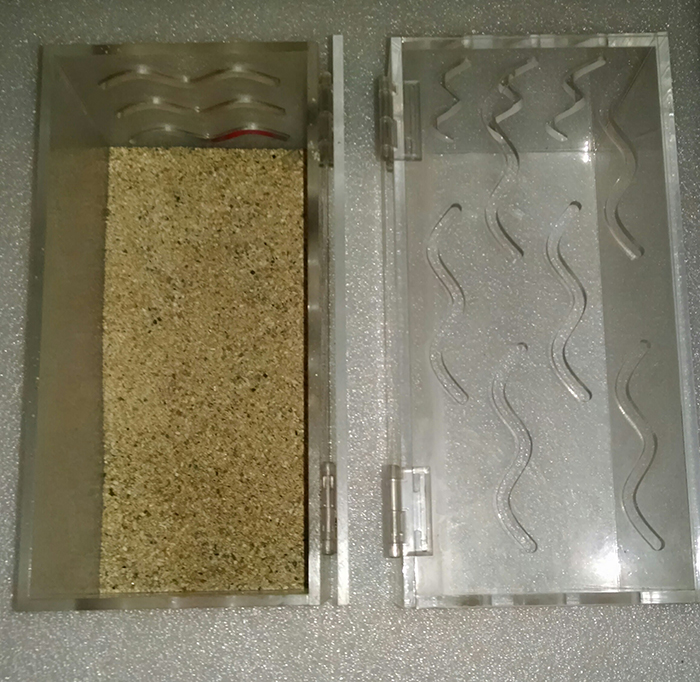
Two of our social acclimation boxes. These are made from ¼” acrylic and sit on the bottom of quarantine or display tanks without any additional weight. There’s a hinged top for feeding and fish access, or you can use a turkey baster to feed through the slots. In some situations we use large submersible magnets to hold them on the pane of a display aquarium. These can be used to house sand for certain species as well.
Social Acclimation
At this point we have our fishes eating prepared foods voraciously and we’re finally ready to add them to our display aquarium! It’s now time to utilize a social acclimation box. A social acclimation box is a simple acrylic container with holes or slits on the sides/top/bottom to allow for water and detritus to move through while keeping the fishes apart. They are becoming readily available commercially, or can be DIY’d fairly easily if aesthetics is of no concern. Fishes can see each other and even interact, without any physical contact. If there is going to be major aggression issues you will know fairly quickly when using this method, as the aggressor will literally attack the side of the container housing the new fish. For this reason it’s important to keep appropriate sized PVC fittings within the container providing cover for the new fish. We like to leave fish in the container for a minimum of three days, sometimes more depending on apparent aggression. Fish should be fed normally in the box for the duration of their stay. Once you’re confident the fish is eating normally and you’re not observing any outright aggression it’s time to release the fish. If you are witnessing consistent aggression through the social acclimation period this fish is likely to be mutilated or killed by your existing tank mates, and your best option is to re-home the fish elsewhere. Once you release your new fish from the social acclimation box be ready to diligently observe for a few days. Be prepared to remove the new fish or the overly aggressive existing fish should you choose to keep the new fish in the case of extreme aggression. Dominance shows will ensue with fishes whipping past one another, curling tails around one another, and sometimes nipping fins. Most of these actions are to be expected. Remember it’s a fish eat fish world out there, and territorial aggression is part of their instinct. We always recommend feeding a bit on the heavy side to help keep existing fishes occupied and less interested in the new addition.
Conclusion
As you can see there are quite a few simple things we can do to help ease fish into their new homes. We have to remember that every time we add a fish with established fishes we’re literally throwing them into battle deep into enemy territory. The dump and hope approach should be way out the window at this point, however if that is still your forte and you continue to lose fishes it’s time to search for a new hobby. These fishes have overcome all odds to get into our care the least we can do is make sure we provide them a fighting chance in their new environment. By no means is any of the above information set in stone, as you likely know by now in our wonderful hobby there’s a million ways to skin a cat. However these steps have allowed me to mix combinations of fishes together that most local fish stores would laugh at you for even mentioning, with amazing success. These steps allow even the most skittish of fishes to settle in on their own accord rather than being forced into a death trap. Now go get that quarantine tank established and let it run while you wait for your next addition to become available.



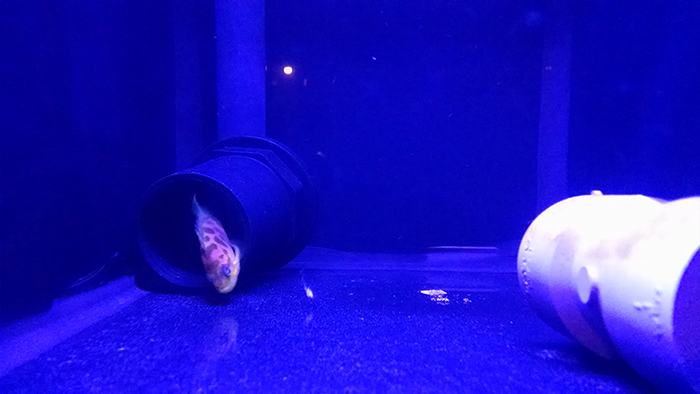



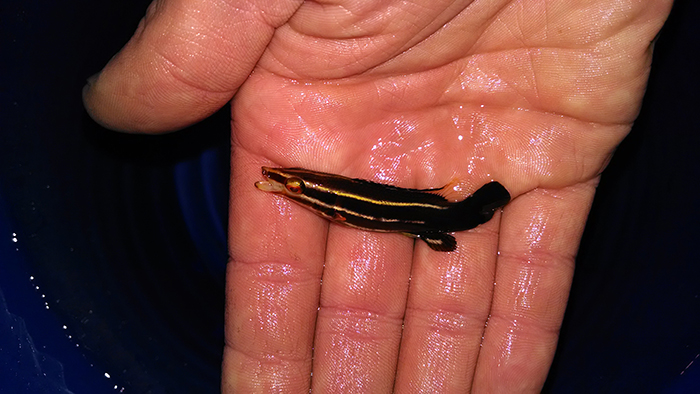

0 Comments